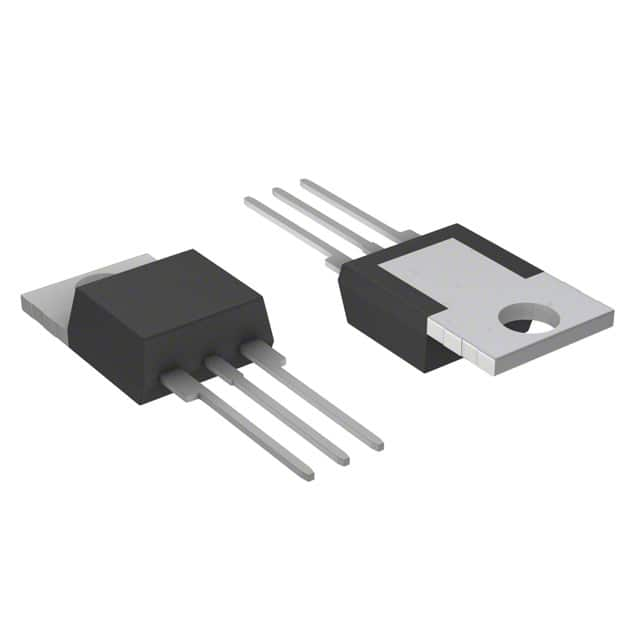Q6025R6 Product Overview
Introduction
The Q6025R6 is a semiconductor device belonging to the category of triacs. It is commonly used in electronic circuits for controlling AC power. This entry provides an overview of the Q6025R6, including its basic information, specifications, pin configuration, functional features, advantages and disadvantages, working principles, application field plans, and alternative models.
Basic Information Overview
- Category: Semiconductor/Triac
- Use: Control of AC power in electronic circuits
- Characteristics: High voltage capability, high surge current capability, sensitive gate triggering, and low holding current
- Package: TO-220AB
- Essence: Power control in AC applications
- Packaging/Quantity: Typically sold in reels or tubes containing multiple units
Specifications
- Voltage Rating: 600V
- Current Rating: 25A
- Gate Trigger Current (Max): 50mA
- On-State Voltage (Max): 1.7V
- Holding Current (Max): 40mA
- Critical Rate of Rise of Off-State Voltage (Min): 50V/µs
Detailed Pin Configuration
The Q6025R6 typically has three pins: MT1, MT2, and gate. The MT1 and MT2 pins are used for the main current flow, while the gate pin is used to trigger the triac into conduction.
Functional Features
- Sensitive gate triggering for reliable control
- High surge current capability for robust performance
- Low holding current for efficient operation
- High voltage capability for versatile applications
Advantages and Disadvantages
Advantages
- Reliable and precise AC power control
- Robust surge current handling capability
- Low holding current for energy efficiency
Disadvantages
- Sensitivity to external noise and interference
- Limited maximum voltage and current ratings compared to some other power control devices
Working Principles
The Q6025R6 operates based on the principle of bidirectional conduction, allowing it to control the flow of AC power by triggering the device into conduction using the gate signal.
Detailed Application Field Plans
The Q6025R6 finds extensive use in various applications, including: - Dimmer switches - Motor speed control - Lighting control - Heating control
Detailed and Complete Alternative Models
Some alternative models to the Q6025R6 include: - Q6015R5 - Q6035R6 - BTA25-600B
In conclusion, the Q6025R6 is a versatile triac semiconductor device with specific characteristics and capabilities that make it suitable for controlling AC power in various electronic applications.
Word count: 345
Senaraikan 10 soalan dan jawapan biasa yang berkaitan dengan aplikasi Q6025R6 dalam penyelesaian teknikal
What is Q6025R6?
- Q6025R6 is a commonly used silicon-controlled rectifier (SCR) that is designed for high performance and reliability in various technical solutions.
What are the typical applications of Q6025R6?
- Q6025R6 is often used in power control, motor control, lighting control, and other industrial applications where precise and reliable switching is required.
What is the maximum voltage and current rating of Q6025R6?
- The maximum voltage rating of Q6025R6 is typically around 600V, and the maximum current rating is around 25A.
How does Q6025R6 compare to other SCRs in terms of performance?
- Q6025R6 offers excellent performance in terms of on-state voltage drop, holding current, and surge capability, making it a popular choice for demanding technical solutions.
What are the key features of Q6025R6 that make it suitable for technical solutions?
- Q6025R6 features high commutation capability, low thermal resistance, and high surge current capability, making it well-suited for challenging technical applications.
Are there any specific thermal management considerations for using Q6025R6 in technical solutions?
- It is important to ensure proper heat sinking and thermal management to maintain the optimal operating temperature of Q6025R6, especially in high-power applications.
Can Q6025R6 be used in both AC and DC applications?
- Yes, Q6025R6 is designed to be used in both AC and DC power control applications, providing versatility in technical solutions.
What are the recommended mounting and assembly techniques for Q6025R6?
- Q6025R6 is typically mounted using standard techniques such as through-hole mounting or surface mounting, following the manufacturer's recommended guidelines for assembly.
Is Q6025R6 suitable for use in harsh environmental conditions?
- Q6025R6 is designed to withstand a wide range of environmental conditions, but it is important to consider factors such as humidity, temperature, and vibration when integrating it into technical solutions.
Are there any common failure modes or reliability concerns associated with Q6025R6?
- While Q6025R6 is known for its reliability, common failure modes can include overvoltage stress, thermal overstress, and improper handling during assembly, so proper design and usage practices are essential for ensuring long-term reliability in technical solutions.


